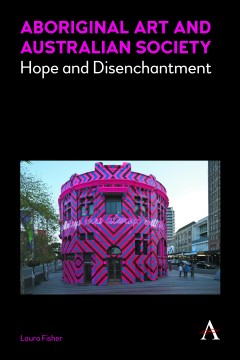Aboriginal Art and Australian Society
Hope and Disenchantment
By Laura Fisher
- About This Book
- Reviews
- Author Information
- Series
- Table of Contents
- Links
- Podcasts
About This Book
The Aboriginal art movement flourished during a period in which the Australian public were awakened to the implications of the state’s decision to confront the legacies of colonisation and bring Aboriginal culture into the heart of national public life. Rather than seeing this radical political and social transformation as mere context for Aboriginal art’s emergence, this study argues that Aboriginal art has in fact mediated Australian society’s negotiation of the changing status of Aboriginal culture over the last century. This argument is illustrated through the analysis of Aboriginal art’s volatility as both a high art movement and a phenomenon of visual and commercial culture. This analysis reveals the agendas to which Aboriginal art has been anchored at the nexus of the redemptive project of the settler state, Indigenous movements for rights and recognition, and the aspirations of progressive civil society.
At its heart this study is concerned with the broader social and cultural insights that can be gleaned from conducting a sustained inquiry into Aboriginal art’s contested meanings. To achieve this it focuses upon the hopeful and disenchanted faces of the Aboriginal art phenomenon: the ideals of cultural revitalisation and empowerment that have converged upon the art, and the countervailing narratives of exploitation, degradation and futility. Both aspects are traced through a range of settings in which the tensions surrounding Aboriginal art’s aesthetic, political and significance have been negotiated. It is in this dialectic that the vexed ethical questions underlying Australia’s settler state condition can most clearly be identified, and we can begin to navigate the paradoxes and impasses underlying the redemptive national project of the post-assimilation era.
Reviews
'Like any tightrope walker, Laura Fisher has a finely attuned sense of balance. Her clear-sighted analysis of the historical record takes her beyond the moral high ground and ideological posturing that for decades have stifled intelligent discussion of the mixed blessings of Aboriginal art’s success. This book should be essential reading for anyone to whom Indigenous art is more than a just a pretty picture.' —Vivien Johnson, former NewSouth Global Professor, University of New South Wales and author of 'Lives of the Papunya Tula Artists'
Author Information
Laura Fisher is a sociologist and art historian based in Sydney, Australia. She is pursuing a range of research interests around art in the public domain, visionary outdoor environments, the cultural economy and Aboriginal art. She is currently a post-doctoral research fellow at Sydney College of the Arts, University of Sydney.
Series
Anthem Studies in Australian Literature and Culture
Table of Contents
Introduction; Part I: Governance, Nationhood and Civil Society; Chapter 1: New Intercultural Relationships in the Post-Assimilation Era; Chapter 2: Aboriginal People Mobilising Aboriginal Art; Chapter 3: Understanding Aboriginal Art Subsidy; Chapter 4: The State Mobilising Aboriginal Art; Chapter 5: ‘Aboriginal culture’ at the Nexus of Justice, Recognition and Redemption; Part II: Contemporary Aboriginal Art in the 1980s; Chapter 6: The Emergence of Aboriginal Art in the 1980s; Part III: Negotiating Difference; Chapter 7: Negotiation Aboriginal Difference; Chapter 8: The Art/Anthropology Binary; Part IV: Aboriginal Art, Money and the Market; Chapter 9: Ethics and Exploitation in the Aboriginal Art Market; Chapter 10: ‘Aboriginal Mass Culture’ and the Cultural Industries; Conclusion.
Links
Stay Updated
Information
Latest Tweets



